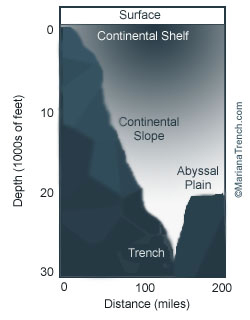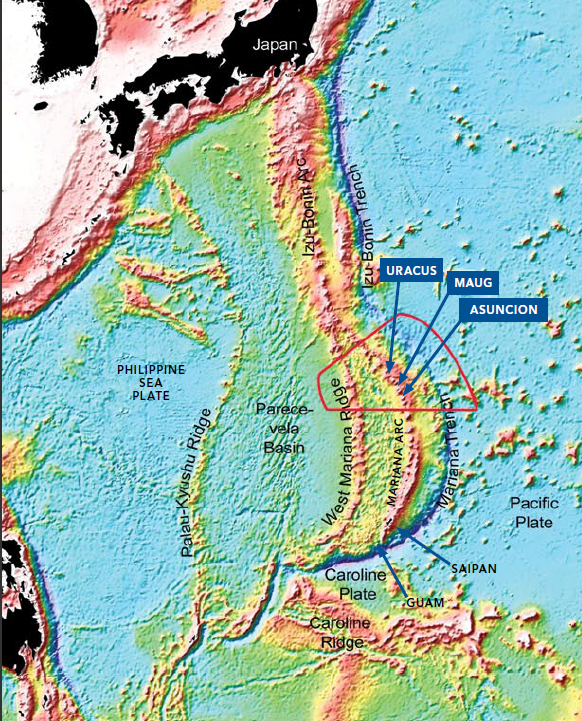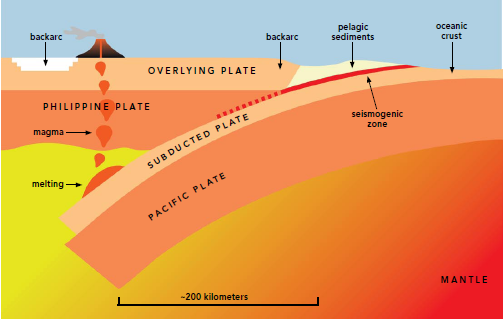Different branches of science have among its purposes one common aim, which is explanation. Different scientific, methods related to different areas of science, tends to describe and frame the unexplained and unknown. In terms of geology and oceanography, one of the subjects attracting the minds of the scientists is concerned with the Mariana Trench. In that regard, this paper attempts to cover the aforementioned topic through a review of the literature connected Mariana Trench, its geological aspects, causes, and scientific trends.
Defining the Mariana Trench, it can be stated that it is a location “at which the Pacific plate subducts beneath the eastern edge of the Philippine Sea plate”, and which contains The Challenger Deep “the deepest oceanic trench in the world, and is up to 2 km deeper than the average depth along the axis of the Mariana Trench” (Michibayashi et al. 111). With that said, it can be seen that one of the main causes of the increased interest to Mariana Trench is its depth, and as Souren suggests, it may sound astonishing for one to hear that scientists do not know precisely how deep the Mariana Trench is (See Fig.1).

Even though scientists send sound waves through the water and study their reflection, the results obtained need interpretation and translation into meaningful data, since the results do not shows exact measurements. In that regard, new technologies are used to ensure that more exact measurements are achieved and adjustment of older data is being made. Following the previous paragraph, it can be assumed that scientists do not seem to know the exact measurements of the Mariana Trench, which can be confirmed through the literature/ history of geology, where different numbers were used to indicate the approximate depth of the Mariana Trench. The main measurements varied between 10.990 m, by Soviet Vessel Vitiaz in 1957, later corrected to 11.034, 10.911 m in 1960 by bathyscaphe Trieste, 10.924 m, through a survey conducted in 1984, 10.550 m by the Japanese vessel Hakuho Maru in 1992, later corrected to 10.933 m, and then 10.898 m, during dives in 1995 and 1996, and 10.744 m in a 2003 study (Souren). It can be seen that the variation are slight, compared to the overall depth of the trench, which description can be better perceived through the comparison to the highest point on the earth, i.e. Mount Everest, where it was estimated that if the mount was set in the Mariana Trench, “there would still be 2,183 meters (7,166 feet) of water left above it” (Mariana Trench). There are still efforts in search of a precise measurement of the Trench
In that regard, despite the known fact that Mariana Trench is the deepest zone on earth, scientists strived to find the exact measurements of the trench depth. A glimpse of the way the data was gathered at different intervals indicates the way the technological progression facilitates the efforts of the scientists. In that regard, the topographic survey conducted on the Japanese S/V Takuyo in 1984, can be seen as an example of such progression, where a Narrow Multi-Beam Echo Sounder (Sea Beam) was used, “for about 500 miles in sounding lines covering an area of about 140 km2 in Challenger Deep in Mariana Trench” (Nishida, Muneta and Kondo). The usage of such tools confirmed the record for the world’s deepest depth, instead of the results of Vitiaz (1957). The corrections made considered such data as water temperature and salinity, which in turn inserted corrections in the sound velocity, through which the measurement was achieved.
There are so many explanations about Mariana Trench’s history and location from various scientists and authors. The geographical information according to the sources cited in this paper locates the trench between two high areas: the Ogasawa Plateau (in the north) and the Caroline Ridge (in the south) (Souren), north of New Guinea, about 250 miles of Guam, which is part of the beautiful Mariana Islands (See Fig.2) (Encyclopedia).

Even the Guinness Book of Records quotes the Northern Marianas as having the most fair and impartial climate in the world, with an average temperature of 85°C per year (Souren). The fact that Mariana Trench is the deepest point on earth, as Souren argues, makes people wonder if it is a pinhole, where the trench is more than 2400 kilometers long and on an average nearly 70 kilometers wide (Souren). Mariana Trench contains several deep points called deeps, and the deepest of them is called Challenger Deep.
In terms of the location significance, it can be seen that its importance is apparent, where President Bush decided to set aside some large piece of land of American-managed territory in the Pacific, including the waters around the Northern Mariana Islands. Mariana’s trench depth is of nearly 11kilometres, and what makes it so deep are the particular plates involved, which make Mariana Trench an interesting site to explore. The Pacific plate is moving westward and thrust below the Philippine plate, which is too old and cold. Accordingly, it is subducted along the western Pacific, and sinks into the mantle very fast.
The Mariana Trench is most precious site, and can be considered among the best places in the world to accomplish conservation at a truly oceanic scale. In additional to the admiration of the president Bush regarding Mariana Trench, its scientific importance can be seen through the proposal to establish Mariana Trench National Monument in the Commonwealth of the Northern Mariana Islands (CNMI) (Global Ocean Legacy). The protection and the honor of the site of the deepest point on Earth include the surrounding arc of undersea volcanoes and the thermal vents around Mariana trench area (Encyclopedia). This unique geological region is more than five times longer than the Grand gorge, it is deeper than Mount Everest, the highest mountain on earth, and it supports life in some of the harshest conditions beyond human imagination (Encyclopedia). In addition, Britannica points out to a large number of species surviving amid hydrogen-emitting volcanoes, hydrothermal vents that produce highly concentrated acid, boiling water and the only known location of liquid sulfur. It comes to a surprise, how such a phenomenon might exists, but the reality is: there are living creatures at the bottom of the trench and how they survive remains a mystery.
Most trenches occur around the edge of the Pacific Oceans and they occur in the northeast Indian Ocean like a Java Trench. Paul and Brian explain how the deepest point on the surface of the Earth occurred in Challenger Deep, at the bottom of the Mariana Trench in the western Pacific. As seen on various maps, trenches are narrow, elongated, and actuate, and probably thousands of kilometers long. Paul and Brian suggest that, oceanic lithosphere has a very similar density as that of underlying asthenosphere, with oceanic plate converging with another plate easily subducted. They further explain how one of the most noticeable features of most trenches is the actuate plan, convex toward the subducting plate. The way a spherical cap of lithospheres deforms, when bent at a seduction zone, accounts for how it changes from convex upwards on the seabed to concave upwards in the sub-ducting slab, which makes the trench follow the boundary between the convex and concave part. The latter describes the circular arc on the surface of the trench (Paul and Brian).
In that matter, the earth’s crust is not one solid piece of rock; it is thin, like the shell of an egg. In fact, the earth crust results from a large plate of thin crust that floats on the molten rock of the earth’s mantle. While floating around on the mantle, the edges of these plates slide over, bump into each other, and occasionally crash. The oceanic crust is much heavier than the continental crust so when the plates crash into each other, the oceanic plate plunges downward toward the molten mantle, while the lighter, continental plate overlaps it.
The forces driving the two plates together are intense, and thus, the underlying oceanic plate creates a trench where it drags the edge of the continental crust down as it descends beneath. For the earthquake to occur, most authors believe that the ground along either side of a fault moves allowing the earthquakes to happen due to a certain level of depth, caused by the movement of tectonic plate. Faults are cracks in the earth caused by buckling and tension from the movement of the tectonic plates. Pressure along fault lines usually occurs along plate boundaries. Following the Paul and Brian’s explanation, it should be stated that over the next thirty years, many new surprising discoveries allowed new technologies to be developed for the sake of exploring the ocean bed.
The volcanic activities are the main contribution as to why earthquake occurs, and therefore, such fact forced scientists to come up with techniques of making instruments that could measure earthquake activity around the world. The collaboration of the scientists as a team resulted in drawing a new map of the world, showing volcanic and earthquake activity. The latter allowed focusing on certain areas that appeared like the margins of huge crustal plates (Paul and Brian).
When geologists discuss the deepest areas, it can be assumed that they refer simply to the far end that we can dive. This is an area, which is far much beyond diving reach and that is why it implies the usage of such technological tools as echo sounder vessels and many other technologies, which are used to record the precise measurement of the trench depth.
It can be assumed that the scientists’ main wish regarding the Mariana Trench is to open it and to stop the water flowing to have a chance to find out the precise depth of the trench. Paul and Brian talk about a depth that is so far down in the ocean that it is hard to fathom (a fathom is a unit of length in Standard English used to measure ocean depths and deeps). The Trench is so deep that it takes hours to free fall to the ocean bed. According to Paul and Brian, the scientists explain how studying this inner ocean space is an exceptional science, where the oceans are much deeper than anything above the ground is. (Paul and Brian) “Many people say that the ocean realm is truly the last border on earth”. In terms of oceans, it can be stated in confidence that the proportion of the known and the unknown facts indicate that there are still to study and research, which makes being a scientist in this exciting field such an adventure.
The study of the species living in such extreme conditions allows the scientists to trace the evolution of many of them during their adaptation to the extreme conditions found in such areas. In that regard, the deepest part of the ocean, known as abyssal zone, contains many examples of such species. An example can be seen through Angler Fish, a fish using “bioluminescent (life light) protrusion to attract its prey” (Mariana Trench). In that regard, it can be seen that such fish would be found only in areas, which are dark, so that the fish can attract their prey, a perfect example of which is the Mariana Trench. “Most of the planet’s oceans are very dark. At a depth of 150 meters (approx. 500 feet), there is little if any light left, and colors are no longer visible to the human eye (Mariana Trench).
Describing extreme conditions, a glimpse of these conditions might give an idea of the kind of adaptations these species go through. The Challenger Deep in particular is very cold and pressurized, while the floor has vents with hydrothermal (hot water) vents, with temperature reaching 300° Celsius (572° Fahrenheit) (Mariana Trench). At the same time, the surrounding water is freezing, not to mention the differences in acidity, where venting fluid is highly acidic, “while the water from the deep ocean is slightly basic” (Mariana Trench). Thus, it can be seen that the species living in such conditions have an extreme resistance to extreme temperatures on both sides of the scale. In addition to the angler fish, crabs are also among the habitats of the Mariana Trench, in addition to nearly over 200 different microorganisms (Mariana Trench).
Mariana trench is the deepest zone of the earth’s surface, and a lot of discussions and reviews by different authors and scientists are conducted to bring about the reality about the Mariana trench theory and practice. With a lot of vagueness surrounding the Mariana Trench, every scientist is chasing precise results regarding various areas related to Mariana Trench, whether geology, biology, oceanography or others. In that regard, it can be said that a relative success was reached in that matter, where there is a new discovery each time the scientists decide to work on a deferent agenda
Challenger Deep in the Mariana Trench is the deepest point in Earth’s oceans. It is 10,924 meters (35,840 feet) below sea level. Souren indicates that the naming of Challenger Deep was after the British survey ship Challenger II, which discovered the very deep location in 1951. She further explains how the Woods Hole Oceanographic Institute had a scientist who was the first one to design a deep-sea robotic vehicle that discovered deepest survey.
Answering the question of the creation of volcanic islands, scientists attempted to apply various theories, which will attempt to answer such question. One of such theories is the hot spots, where Dr. J. Tuzo, a geophysicist, explained the existence of volcanic activity through the existence of hot spots that existed under the earth’s crust. The spots were named so due to the concentration of heat in small areas (See Figure 3).

The heat causing the overlying rock to melt, and due to the fact that the liquid magma is lighter than the surrounding rock, “”floats” to the surface and forces its way out of fissures in the crust” (Extreme Science). According to Paul and Brian, for the past 30 years, there have been modern technologies used to map the topography of the sea floor, revealing a profile of the sea floor that is nothing but flat and lifeless.
The conclusion can be seen through the statement that the science currently holds facts regarding space more than there are facts regarding the ocean. In that regard, it can be seen that with each discovery there are more questions lying ahead. Nevertheless, the progress made should not be underestimated, where the discoveries made regarding the Mariana Trench already changed the way the world perceives the ocean. The latter can be seen as a contribution of science with its various branches, specifically geology and oceanography, owing to which “No longer is the sea considered to be a bottomless, black abyss, the sea floor a vast expanse of cold, flat, lifeless watery desert” (Extreme Science).
I personally believe that scientists’ efforts will be compensated, since they work day and night to achieve their goals in terms of discovering various aspects of Mariana Trench. The main aspect is not to perceive such area of science as a limited field, the knowledge of which is to be reached instantaneously, but rather as a branched tree, where with each branch located a new branch would occur afterwards. The available literature, in terms of articles, journals, news papers, internet sites and books all shows a positive progress towards obtaining more precise results, such as the progress seen in measuring the depth of the Mariana Trench, knowledge regarding the species in the trench and many other aspects. The contributions of authors and researchers are helpful in retrieving scientific information, which with the progress of internet technologies is accessible for the public.
References
Angelina Souren. “Introduction to Mariana Trench”. Challenger Deep 2008. Web.
Encyclopedia Britannica. “Trench, Pacific Ocean” Mariana Trench. 2009. Web.
Extreme Science. “Geography of the Sea“. 2008. Extreme Science. Web.
Global Ocean Legacy. “The Deepest Ocean on Earth”. 2008. Global Ocean Legacy. Web.
Mariana Trench. “The Mariana Trench – Biology“. 2003. The Mariana Trench.com. Web.
Michibayashi, Katsuyoshi, et al. “Variable Microstructure of Peridotite Samples from the Southern Mariana Trench: Evidence of a Complex Tectonic Evolution.” Tectonophysics 444 1-4 (2007): 111-18. Print.
Nishida, Hideo, Kenji Muneta, and Tadashi Kondo. ” Mariana Trench “. 1984. Gebco.Net. Web.
Paul Hancock and Brian J. Skinner. “Deep-sea trenches” The Oxford Companion to the Earth. 2002. Web.